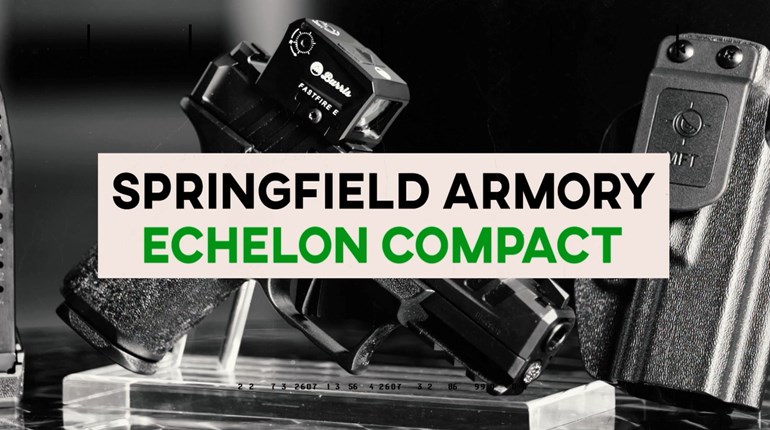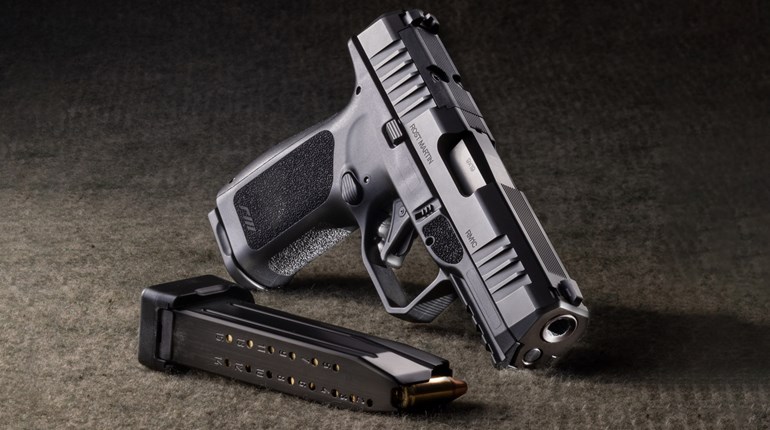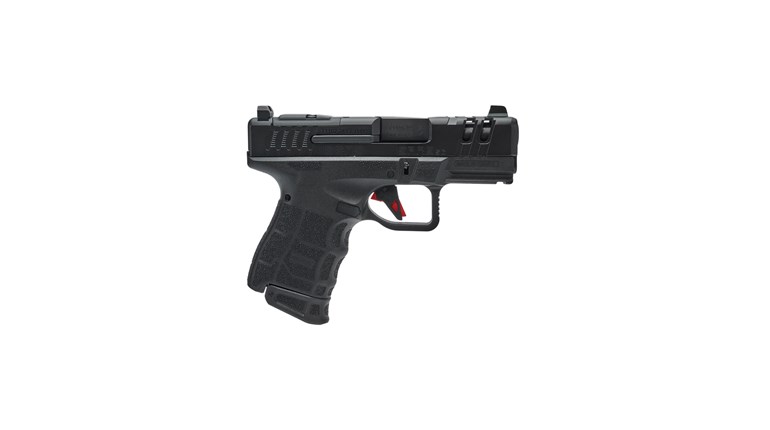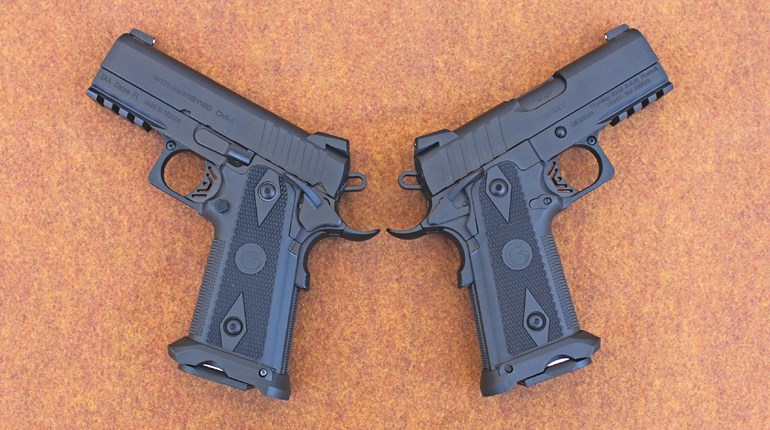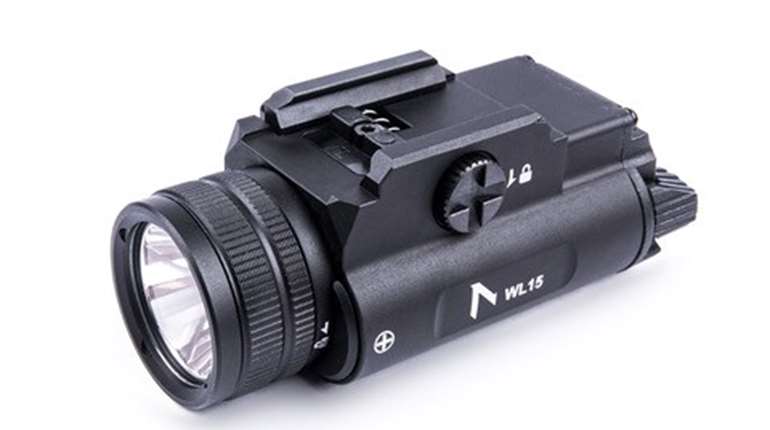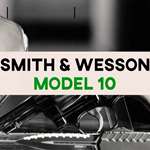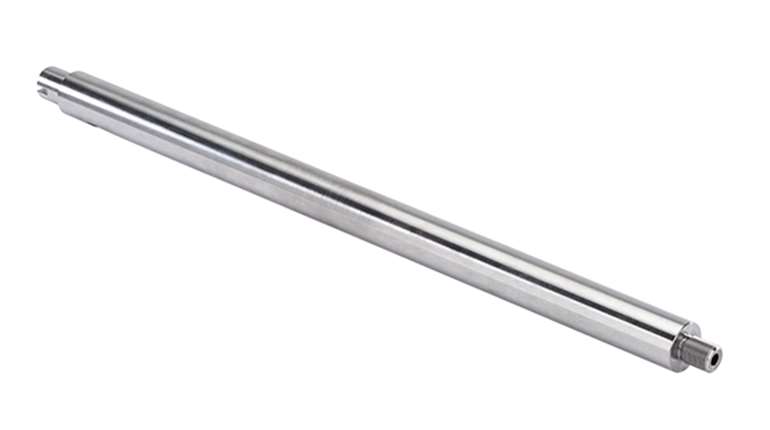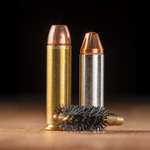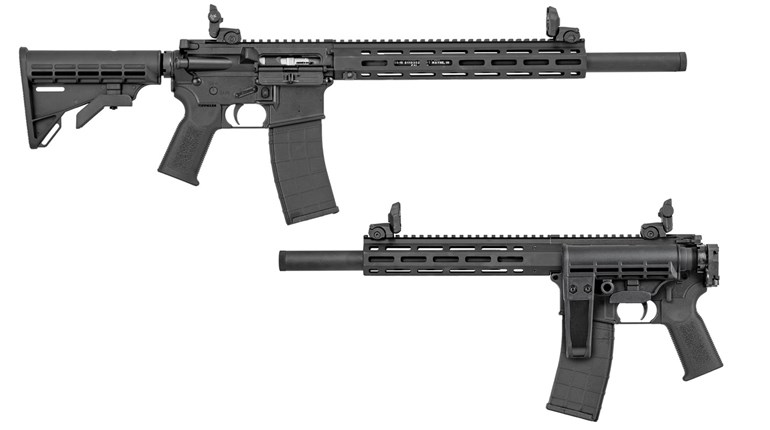** When you buy products through the links on our site, we may earn a commission that supports NRA's mission to protect, preserve and defend the Second Amendment. **
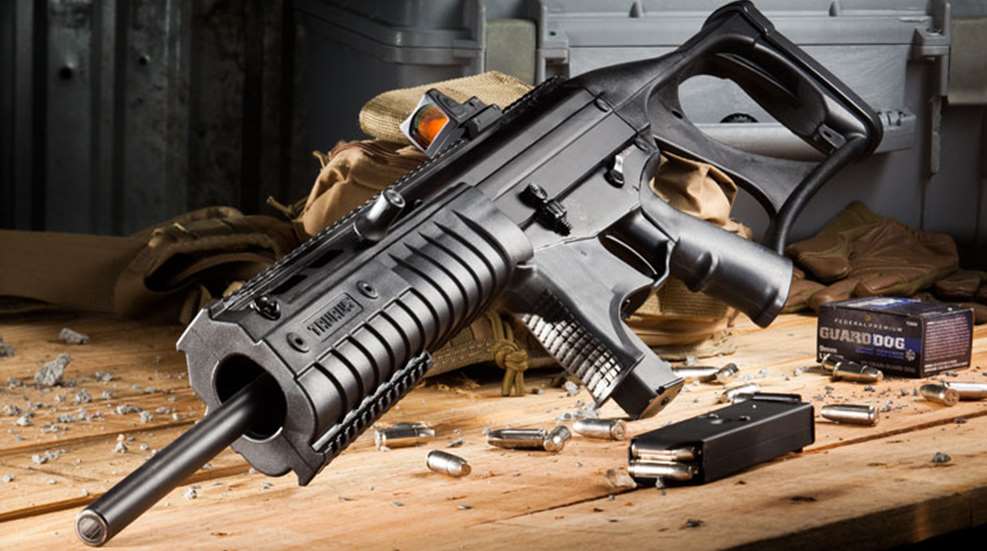
Taurus has been in the firearms business for more than 70 years, mainly producing Brazilian-made revolvers and pistols. The company has designed several models that have had quite an impact on American shooters, but the latest example of Taurus innovation at work comes in the form of a new carbine. The CT9 is a semi-automatic, 10+1-round capacity, blowback-operated 9 mm carbine designed for personal protection.
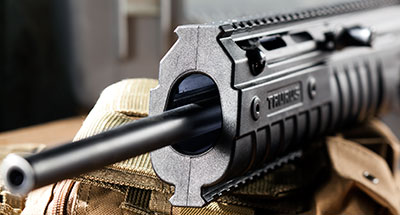 Some may ask, “Why bother with a pistol-caliber carbine?” Well, there are many good reasons. Experienced shooters have relied on longarms sharing the same cartridge as their handguns for a long time. One famous example is the .44-40 Win., which frontiersmen used in both the Winchester Model 1873 lever-action rifle and the Colt Single Action Army revolver. This common cartridge for both rifle and handgun offered incredible convenience, since people on the frontier had limited supply options. With the .44-40 Win. combination, they only had to worry about carrying sufficient amounts of one type of ammunition. The rifle’s longer barrel boosted the cartridge’s velocity, range and effectiveness, while its stock, improved sights and longer sight radius significantly improved accuracy. Shooters could choose between the compact convenience of a handgun, or the range and effectiveness of a rifle, depending on the situation.
Some may ask, “Why bother with a pistol-caliber carbine?” Well, there are many good reasons. Experienced shooters have relied on longarms sharing the same cartridge as their handguns for a long time. One famous example is the .44-40 Win., which frontiersmen used in both the Winchester Model 1873 lever-action rifle and the Colt Single Action Army revolver. This common cartridge for both rifle and handgun offered incredible convenience, since people on the frontier had limited supply options. With the .44-40 Win. combination, they only had to worry about carrying sufficient amounts of one type of ammunition. The rifle’s longer barrel boosted the cartridge’s velocity, range and effectiveness, while its stock, improved sights and longer sight radius significantly improved accuracy. Shooters could choose between the compact convenience of a handgun, or the range and effectiveness of a rifle, depending on the situation.
Pistol-caliber carbines are more commonly associated with semi-automatic versions of submachine guns, and indeed the CT9 began as exactly that. This carbine is based on the Taurus MT G2 submachine gun, introduced in 2011 to update and replace existing arms in Brazilian police arsenals. The MT G2 fires from the closed-bolt position, which helps improve accuracy over an open-bolt, full-automatic system. It also made it easier to produce a semi-automatic variant, since such guns require closed-bolt operation.
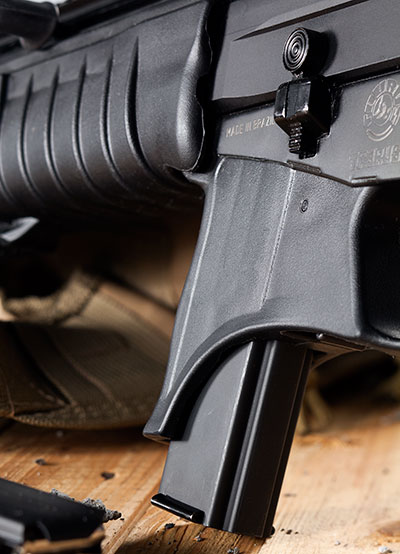 Making a semi-auto version was certainly a no-brainer for Taurus. The company had all the tooling and equipment set up to produce the MT G2, and it was a fairly simple conversion to turn it into an importable carbine—much like the Uzi and other military submachine guns in the past. Consumers get the benefit of a tried-and-tested system that meets military and law enforcement requirements for function and reliability, while the company is able to expand its market.
Making a semi-auto version was certainly a no-brainer for Taurus. The company had all the tooling and equipment set up to produce the MT G2, and it was a fairly simple conversion to turn it into an importable carbine—much like the Uzi and other military submachine guns in the past. Consumers get the benefit of a tried-and-tested system that meets military and law enforcement requirements for function and reliability, while the company is able to expand its market.
The CT9 uses a reliable blowback-operated system. There are no gas tubes, pistons or roller locks, just one very large and heavy bolt. Indeed, on my scale, the bolt assembly weighed 1.5 pounds. All semi-automatics must have a way of keeping the bolt closed until the pressure in the chamber from a fired cartridge drops to a safe level. Blowback systems do this primarily through inertia and work best with low-pressure rounds. Higher pressure rounds mean a heavier bolt is required, which is why blowback-operated handguns are seldom chambered in anything greater than .380 ACP; the 9 mm cartridge is a high-pressure pistol round. In a carbine, however, the system works very well and has been used in sub-machine guns throughout history.
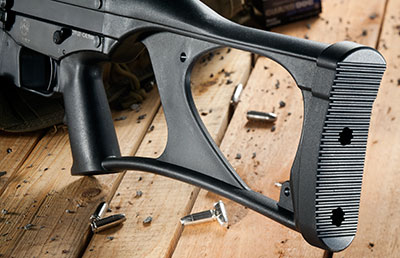 The upper receiver of the CT9 is constructed of hard-coat-anodized aluminum. There is a full-length Picatinny rail along the top of the receiver, which provides 18 inches of space for mounting optics, magnifiers and/or night-vision devices. The front of the receiver features cooling slots along the top to help dissipate barrel heat.
The upper receiver of the CT9 is constructed of hard-coat-anodized aluminum. There is a full-length Picatinny rail along the top of the receiver, which provides 18 inches of space for mounting optics, magnifiers and/or night-vision devices. The front of the receiver features cooling slots along the top to help dissipate barrel heat.
Polymer front and rear sights come installed on the carbine, and they can be easily moved anywhere along the top rail or removed entirely if desired. Each features a spring-loaded tab that allows the sights to slide along the rail and then lock in place. To remove the sights, both have to slide off the back of the receiver. The sights are sturdy and easy to acquire. The front sight features a hooded post with a fixed, bright-white dot, and the rear sight is windage and elevation adjustable, offering both an aperture and a notch with a white outline.
The forward-mounted, nonfolding charging handle sits in the receiver above the handguard about halfway down. It features a curved polymer gripping area for comfort and does not reciprocate when the rife is fired. This is certainly a welcome feature, because reciprocating charging handles located in this area have a tendency to catch wayward thumbs or cover, which can ruin your day. The charging handle is reversible for right- or left-handed use, another added benefit on the CT9.
Southpaws will also appreciate the other controls on the carbine, which are entirely ambidextrous. The safety-selector and AR-style bolt catch are mimicked on both sides of the rifle, and the magazine release is a basic paddle that can be operated easily by either hand. The steel safety-selector lever is located just above the pistol grip and is identical on both sides. Push it up to engage the safety and down to fire the rifle. I found it difficult to reach with my thumb while properly holding the pistol grip, and I needed to adjust my grip to reach it. Like the safety, the bolt release is steel and identical on both sides of the CT9. It resembles the unit found on an AR, with a larger release button at top and a small hold-open tab at the bottom. It proved easy to operate and effective.
The steel paddle-type magazine release is actually located inside the rear of the magazine well, and the operator must reach up into the well to engage the release. While that sounds difficult, it is actually an easy procedure, and the location protects the paddle against unintentional manipulation that could result in the loss of a loaded magazine. Steel magazines drop free when the release is pushed forward, or they can be grasped and pulled out when the release is activated.
The CT9 comes with two, 10-round steel magazines unique to this firearm. In order to import the gun, magazine capacity had to be limited to 10 rounds, which is a drawback. It would have been preferable for Taurus to have made the CT9 capable of using the same magazine as one of the company’s pistols, such as the PT92, since this would have allowed even greater versatility and compatibility between the carbine and a pistol. But alas that was not to be—because the CT9 is based on an existing submachine gun, it requires magazines designed for its parent. In Brazil and for government sales, 34-round magazines are available.
It is conceivable that some enterprising soul could produce a U.S.-made, higher-capacity magazine for the CT9, but even then there still may be concerns with 922r compliance. To quote the federal regulation: “It shall be unlawful for any person to assemble from imported parts any semi-automatic rifle or any shotgun which is identical to any rifle or shotgun prohibited from importation under section 925(d)(3) of this chapter as not being particularly suitable for or readily adaptable to sporting purposes…”
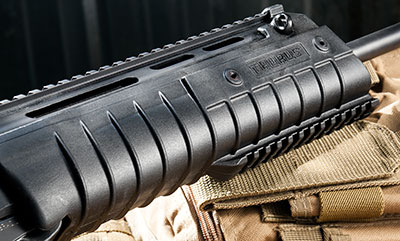 This regulation brings up another small quibble: The polymer stock and pistol grip are a one-piece, skeletonized unit—no doubt a requirement for importation, as the MT G2 on which the CT9 is based has a collapsible and side-folding stock, and a separate pistol grip. The fixed stock is effective and I found it serviceable during testing, but with a set 15.5-inch length of pull, it may prove too long for some users. There are multiple sling attachment points, and the rear buttplate is a removable, solid, ridged-polymer unit. I would prefer a softer, rubberized plate for comfort. It would also be nice if an original-style collapsible and folding stock was available, but that would run into the same compliance problems as a larger magazine.
This regulation brings up another small quibble: The polymer stock and pistol grip are a one-piece, skeletonized unit—no doubt a requirement for importation, as the MT G2 on which the CT9 is based has a collapsible and side-folding stock, and a separate pistol grip. The fixed stock is effective and I found it serviceable during testing, but with a set 15.5-inch length of pull, it may prove too long for some users. There are multiple sling attachment points, and the rear buttplate is a removable, solid, ridged-polymer unit. I would prefer a softer, rubberized plate for comfort. It would also be nice if an original-style collapsible and folding stock was available, but that would run into the same compliance problems as a larger magazine.
At the other end of the CT9, its ridged handguard is also polymer and does not make contact with the barrel, allowing it to remain free floating. As a result, it stayed cool to the touch during extended range sessions. The handguard is very comfortable and provides a secure grip. It’s bare at the rear, but a fixed, 5-inch section of rail toward the front offers a place to mount lights or lasers. Near the front of the handguard and on either side are locations for attaching additional rails, which were not included with the carbine, but should be available from Taurus in the near future.
While it is nice that the 16-inch steel barrel is free floated, its legally required length makes the gun a bit unwieldy—but there’s no getting around that concern without creating an NFA item. If Taurus ever decides to produce the CT9 in the U.S., a short- barreled version and one with a threaded barrel to accommodate suppressors would be on my wish list, along with larger-capacity magazines.
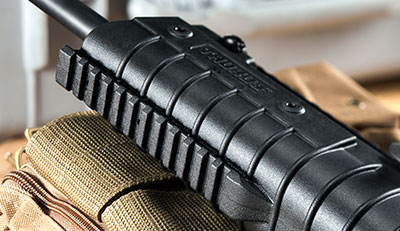 The lower receiver is also rather distinct. It is made from polymer with steel inserts for strength, except the steel inserts are on the outside of the rifle on either side. They mesh very well with the polymer—it is difficult to tell where one material starts and the other ends. These steel side plates carry the Taurus logo and the carbine’s serial number.
The lower receiver is also rather distinct. It is made from polymer with steel inserts for strength, except the steel inserts are on the outside of the rifle on either side. They mesh very well with the polymer—it is difficult to tell where one material starts and the other ends. These steel side plates carry the Taurus logo and the carbine’s serial number.
Like the polymer-steel hybrid lower, the magazine-well design is also unique. It contains the magazine release at the rear and is slightly flared toward the front, making magazine changes easier and faster. The front of the magazine well features a checkered hand hold to act as a vertical gripping surface when employing a close-in hold. Given the carbine’s balance, this was actually quite a comfortable way to deploy it.
Operation of the CT9 is extremely simple and can be mastered in a matter of minutes, even by a novice. Just insert a magazine, retract and release the charging handle, flip the safety off, and it’s ready to roll. This adds to the carbine’s versatility as a home-defense or camp/trunk gun, as it can be used by multiple family members without extensive training. The 9 mm chambering produces little felt recoil, especially considering the CT9 weighed 7 pounds, 4 ounces on my scale when empty (nearly a pound more than advertised).
The blowback operation does send a lot of fouling into the receiver area, and users will notice the top of the magazine and the bright yellow follower show significant carbon buildup after just a few rounds. This does not affect the function of the rifle, but routine maintenance is advisable. In that regard, the CT9 also scores points, because disassembly is incredibly simple—just remove the pin at the rear of the receiver, and the carbine hinges open like an AR. The bolt assembly can then be removed and the carbine cleaned. The bolt assembly stays in one piece, so you end up with a disassembled carbine totaling three pieces, not counting the magazine.
I recently tested a Taurus PT92 pistol in 9 mm, and found the CT9 allowed me to shoot more than twice as accurately and at twice the distance. Some of my groups at 50 yards were inside an inch. Average velocity from the carbine for various tested loads was also about 140 fps greater than that from the handgun.
Drills at speed were easy when using a holographic sight. There was almost no muzzle rise, allowing for quick follow-up shots on target. The single-stage trigger was very smooth, with only a slight amount of overtravel and a clean break at an average pull weight of slightly more than 4.5 pounds.
The CT9 is a firearm that offers a lot of punch, reliability and accuracy as well as value. It is versatile, easy and comfortable to utilize. Shooters looking for a tested design with lots of modern features will be well served with this little carbine.

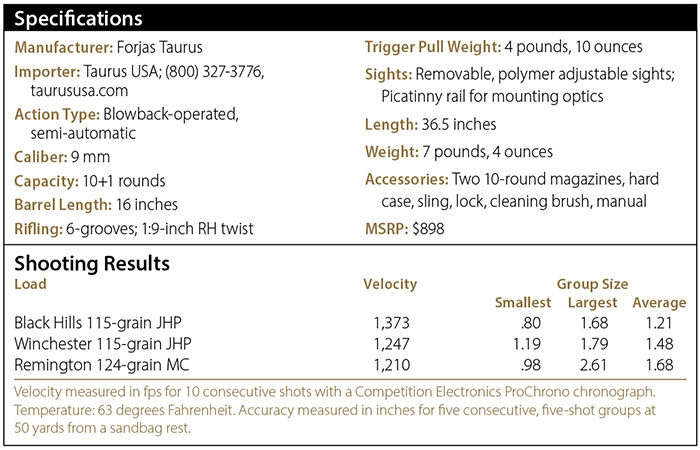

A free-floated barrel increases the CT9’s accuracy potential and does not impart excessive heat to the handguards, meaning the Nomex gloves can stay home when firing.
Pistol-caliber carbines are more commonly associated with semi-automatic versions of submachine guns, and indeed the CT9 began as exactly that. This carbine is based on the Taurus MT G2 submachine gun, introduced in 2011 to update and replace existing arms in Brazilian police arsenals. The MT G2 fires from the closed-bolt position, which helps improve accuracy over an open-bolt, full-automatic system. It also made it easier to produce a semi-automatic variant, since such guns require closed-bolt operation.

An extended, polymer magazine well with molded finger grooves in the front provides purchase for those who prefer a vertical hold on their carbine.
The CT9 uses a reliable blowback-operated system. There are no gas tubes, pistons or roller locks, just one very large and heavy bolt. Indeed, on my scale, the bolt assembly weighed 1.5 pounds. All semi-automatics must have a way of keeping the bolt closed until the pressure in the chamber from a fired cartridge drops to a safe level. Blowback systems do this primarily through inertia and work best with low-pressure rounds. Higher pressure rounds mean a heavier bolt is required, which is why blowback-operated handguns are seldom chambered in anything greater than .380 ACP; the 9 mm cartridge is a high-pressure pistol round. In a carbine, however, the system works very well and has been used in sub-machine guns throughout history.

The skeletonized thumbhole stock is a relic of importation laws, but it proved functional in testing.
Polymer front and rear sights come installed on the carbine, and they can be easily moved anywhere along the top rail or removed entirely if desired. Each features a spring-loaded tab that allows the sights to slide along the rail and then lock in place. To remove the sights, both have to slide off the back of the receiver. The sights are sturdy and easy to acquire. The front sight features a hooded post with a fixed, bright-white dot, and the rear sight is windage and elevation adjustable, offering both an aperture and a notch with a white outline.
The forward-mounted, nonfolding charging handle sits in the receiver above the handguard about halfway down. It features a curved polymer gripping area for comfort and does not reciprocate when the rife is fired. This is certainly a welcome feature, because reciprocating charging handles located in this area have a tendency to catch wayward thumbs or cover, which can ruin your day. The charging handle is reversible for right- or left-handed use, another added benefit on the CT9.
Southpaws will also appreciate the other controls on the carbine, which are entirely ambidextrous. The safety-selector and AR-style bolt catch are mimicked on both sides of the rifle, and the magazine release is a basic paddle that can be operated easily by either hand. The steel safety-selector lever is located just above the pistol grip and is identical on both sides. Push it up to engage the safety and down to fire the rifle. I found it difficult to reach with my thumb while properly holding the pistol grip, and I needed to adjust my grip to reach it. Like the safety, the bolt release is steel and identical on both sides of the CT9. It resembles the unit found on an AR, with a larger release button at top and a small hold-open tab at the bottom. It proved easy to operate and effective.
The steel paddle-type magazine release is actually located inside the rear of the magazine well, and the operator must reach up into the well to engage the release. While that sounds difficult, it is actually an easy procedure, and the location protects the paddle against unintentional manipulation that could result in the loss of a loaded magazine. Steel magazines drop free when the release is pushed forward, or they can be grasped and pulled out when the release is activated.
The CT9 comes with two, 10-round steel magazines unique to this firearm. In order to import the gun, magazine capacity had to be limited to 10 rounds, which is a drawback. It would have been preferable for Taurus to have made the CT9 capable of using the same magazine as one of the company’s pistols, such as the PT92, since this would have allowed even greater versatility and compatibility between the carbine and a pistol. But alas that was not to be—because the CT9 is based on an existing submachine gun, it requires magazines designed for its parent. In Brazil and for government sales, 34-round magazines are available.
It is conceivable that some enterprising soul could produce a U.S.-made, higher-capacity magazine for the CT9, but even then there still may be concerns with 922r compliance. To quote the federal regulation: “It shall be unlawful for any person to assemble from imported parts any semi-automatic rifle or any shotgun which is identical to any rifle or shotgun prohibited from importation under section 925(d)(3) of this chapter as not being particularly suitable for or readily adaptable to sporting purposes…”

Picatinny rails on the top and bottom of the fore-end allow for mounting a variety of accessories and optics.
At the other end of the CT9, its ridged handguard is also polymer and does not make contact with the barrel, allowing it to remain free floating. As a result, it stayed cool to the touch during extended range sessions. The handguard is very comfortable and provides a secure grip. It’s bare at the rear, but a fixed, 5-inch section of rail toward the front offers a place to mount lights or lasers. Near the front of the handguard and on either side are locations for attaching additional rails, which were not included with the carbine, but should be available from Taurus in the near future.
While it is nice that the 16-inch steel barrel is free floated, its legally required length makes the gun a bit unwieldy—but there’s no getting around that concern without creating an NFA item. If Taurus ever decides to produce the CT9 in the U.S., a short- barreled version and one with a threaded barrel to accommodate suppressors would be on my wish list, along with larger-capacity magazines.

Additional rail sections can be added to the sides of the fore-end to provide more mounting points for lights and lasers.
Like the polymer-steel hybrid lower, the magazine-well design is also unique. It contains the magazine release at the rear and is slightly flared toward the front, making magazine changes easier and faster. The front of the magazine well features a checkered hand hold to act as a vertical gripping surface when employing a close-in hold. Given the carbine’s balance, this was actually quite a comfortable way to deploy it.
Operation of the CT9 is extremely simple and can be mastered in a matter of minutes, even by a novice. Just insert a magazine, retract and release the charging handle, flip the safety off, and it’s ready to roll. This adds to the carbine’s versatility as a home-defense or camp/trunk gun, as it can be used by multiple family members without extensive training. The 9 mm chambering produces little felt recoil, especially considering the CT9 weighed 7 pounds, 4 ounces on my scale when empty (nearly a pound more than advertised).
The blowback operation does send a lot of fouling into the receiver area, and users will notice the top of the magazine and the bright yellow follower show significant carbon buildup after just a few rounds. This does not affect the function of the rifle, but routine maintenance is advisable. In that regard, the CT9 also scores points, because disassembly is incredibly simple—just remove the pin at the rear of the receiver, and the carbine hinges open like an AR. The bolt assembly can then be removed and the carbine cleaned. The bolt assembly stays in one piece, so you end up with a disassembled carbine totaling three pieces, not counting the magazine.
I recently tested a Taurus PT92 pistol in 9 mm, and found the CT9 allowed me to shoot more than twice as accurately and at twice the distance. Some of my groups at 50 yards were inside an inch. Average velocity from the carbine for various tested loads was also about 140 fps greater than that from the handgun.
Drills at speed were easy when using a holographic sight. There was almost no muzzle rise, allowing for quick follow-up shots on target. The single-stage trigger was very smooth, with only a slight amount of overtravel and a clean break at an average pull weight of slightly more than 4.5 pounds.
The CT9 is a firearm that offers a lot of punch, reliability and accuracy as well as value. It is versatile, easy and comfortable to utilize. Shooters looking for a tested design with lots of modern features will be well served with this little carbine.

null

null












